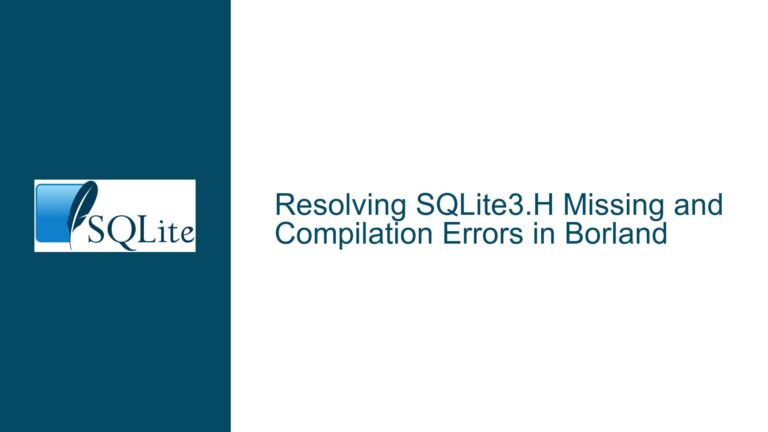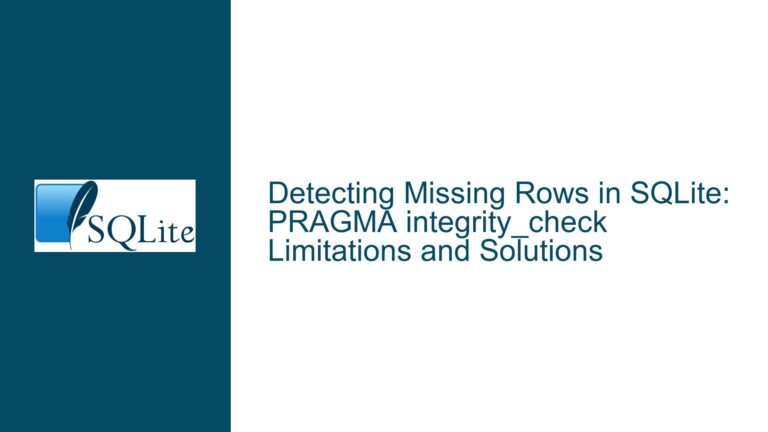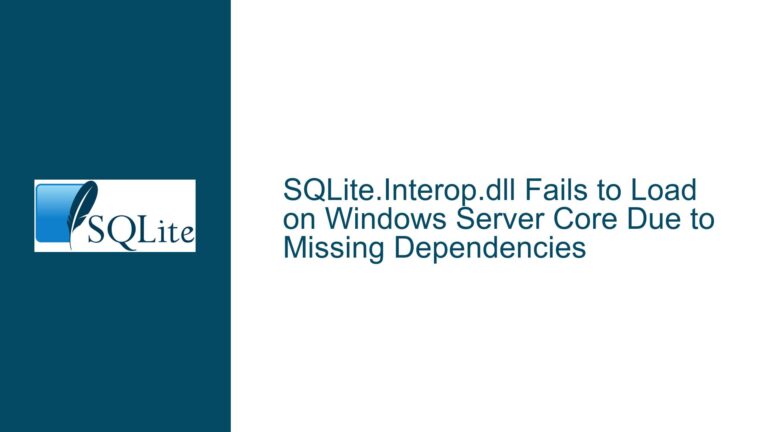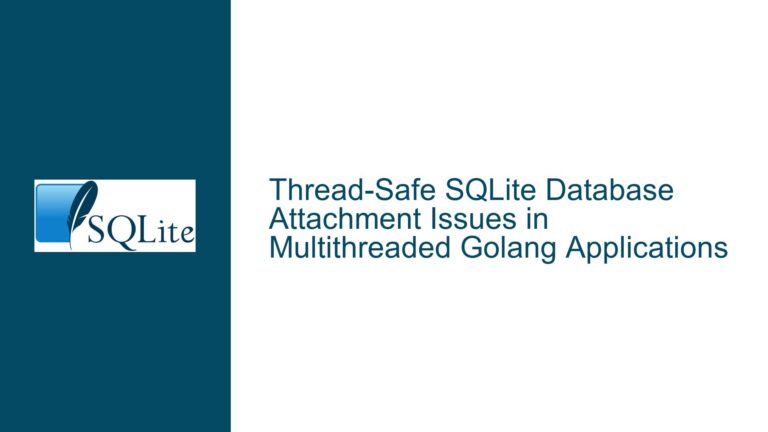Managing Trigger Recursion Depth in SQLite for Controlled Data Operations
Understanding Trigger Recursion Contexts and Constraint Conflicts
Issue Overview
The core challenge involves managing recursive trigger execution in SQLite when attempting to enforce data integrity through trigger logic. This scenario arises when a trigger modifies the same table it monitors, creating a loop that risks infinite recursion or constraint violations. The problem is exacerbated when recursive triggers are enabled (via PRAGMA recursive_triggers=ON;), as SQLite’s default behavior limits recursion depth to prevent stack overflows.
In the provided example, a BEFORE INSERT trigger on table t attempts to enforce unique id values by shifting existing entries upward when a collision occurs. The trigger uses an INSERT ... ON CONFLICT DO UPDATE statement to increment conflicting id values. However, without a mechanism to detect whether the trigger is executing recursively, this logic triggers itself repeatedly, leading to a Runtime error: too many levels of trigger recursion.
The ideal solution would allow the trigger to conditionally execute based on the current recursion depth. For instance, the trigger should modify data only during the initial invocation and suppress further recursive calls. SQLite lacks a native function like recursion_depth() to expose this context, forcing developers to seek workarounds.
Key components of the issue:
- Recursive Trigger Mechanics: SQLite allows triggers to fire recursively up to a predefined limit (default: 1000 levels). This is problematic when triggers modify the same table, as each modification re-invokes the trigger.
- Constraint Enforcement: The
idcolumn’sUNIQUEconstraint must be preserved during insertions. The trigger’s logic attempts to resolve conflicts by incrementingidvalues, but this creates a chain reaction if unchecked. - Context-Aware Execution: The absence of a built-in method to determine recursion depth leaves triggers unable to differentiate between initial and recursive executions.
Root Causes of Uncontrolled Recursion and Constraint Failures
Possible Causes
Unconditional Recursive Trigger Logic:
The trigger’sINSERTstatement lacks a condition to halt recursion. When a new row is inserted, the trigger attempts to adjust existing rows, which in turn fires the same trigger for each adjustment. Without a recursion guard, this creates an infinite loop until SQLite’s recursion limit is reached.Insufficient Control Over Trigger Activation:
SQLite’sWHENclause in triggers allows conditional execution based on column values, but it cannot reference the trigger’s execution context (e.g., recursion depth). This limits the ability to suppress recursion programmatically.Dependency on Recursive Triggers Being Disabled:
IfPRAGMA recursive_triggersisOFF(the default), the trigger logic works as intended because SQLite prevents recursive execution. However, enabling this pragma (for legitimate use cases) breaks the logic, exposing the lack of recursion context awareness.Conflict Resolution Logic Flaws:
TheON CONFLICT DO UPDATEclause incrementsidvalues sequentially, but overlapping updates can cause unique constraint violations if multiple adjustments occur simultaneously. For example, two concurrent insertions targeting the sameidmight increment conflicting rows to the same newid.Lack of Native Recursion Depth Tracking:
SQLite’s API does not expose recursion depth to SQL functions or triggers. Developers cannot natively query whether a trigger is executing recursively or how many levels deep it is.
Implementing Custom Recursion Depth Tracking and Trigger Logic Refinement
Troubleshooting Steps, Solutions & Fixes
Step 1: Add a Custom Recursion Depth Function to SQLite
To address the absence of a built-in recursion depth function, a custom SQLite function can be implemented using the SQLite C API. The function nFrames() counts the number of VDBE (Virtual Database Engine) frames, which correlates with recursion depth.
Implementation Code:
#ifdef SQLITE_CORE
static void _nFrames_(sqlite3_context *context, int argc, sqlite3_value **argv) {
sqlite3_result_int(context, context->pVdbe->nFrame);
}
int sqlite3_nFrames_init(sqlite3 *db, char **pzErrMsg, const sqlite3_api_routines *pApi) {
int nErr = 0;
return sqlite3_create_function(
db,
"nFrames",
0,
SQLITE_UTF8 | SQLITE_INNOCUOUS,
0,
_nFrames_,
0,
0
);
return nErr ? SQLITE_ERROR : SQLITE_OK;
}
#endif
Key Notes:
nFrames()returns the current number of VDBE frames. Each recursive trigger invocation adds a frame.- The function must be compiled into SQLite as a loadable extension or built-in.
Step 2: Modify Trigger Logic to Use nFrames()
Incorporate nFrames() into the trigger’s WHERE clause to conditionally execute based on recursion depth:
CREATE TRIGGER t_bi BEFORE INSERT ON t
BEGIN
INSERT INTO t
SELECT *
FROM t
WHERE id >= NEW.id
AND nFrames() == 1 -- Allow execution only at recursion depth 1
AND EXISTS (SELECT 1 FROM t WHERE id = NEW.id)
ORDER BY id DESC
ON CONFLICT DO UPDATE SET id = id + 1;
END;
Behavior Analysis:
- Initial Insert:
nFrames()returns0during the first trigger execution. TheWHEREclause skips theINSERT, preventing recursion. - Recursive Insert: If the trigger re-invokes itself,
nFrames()increments to1, allowing theINSERTto proceed and adjust conflictingidvalues.
Step 3: Test Recursion Control with Sample Data
Test Case 1: Insert Without Conflicts
INSERT INTO t VALUES (1, 'one'); -- Succeeds (no conflict)
INSERT INTO t VALUES (2, 'two'); -- Succeeds (no conflict)
The trigger does not activate because no id conflicts exist.
Test Case 2: Insert With Conflict
INSERT INTO t VALUES (2, 'second two');
- Initial insert (
id=2) triggerst_bi. nFrames()is0, so theWHEREclause skips the recursiveINSERT.- The original insert proceeds, causing a unique constraint failure on
id=2. - The
ON CONFLICTclause incrementsidto3. - If
id=3is also occupied, the trigger re-executes withnFrames()=1, allowing further adjustments.
Step 4: Refine Conflict Resolution for Ordered Lists
To maintain ordered id sequences during deletions, add an AFTER DELETE trigger:
CREATE TRIGGER t_ad AFTER DELETE ON t
BEGIN
INSERT INTO t
SELECT *
FROM t
WHERE id > OLD.id
AND nFrames() == 1 -- Limit recursion
ORDER BY id
ON CONFLICT DO UPDATE SET id = id - 1;
END;
Behavior:
- Deleting
id=3shifts higheridvalues down (e.g.,4becomes3). - The
nFrames() == 1condition ensures adjustments occur only once per deletion.
Step 5: Validate System-Wide Behavior
Post-Insertion State:
INSERT INTO t VALUES (1, 'one');
INSERT INTO t VALUES (2, 'two');
INSERT INTO t VALUES (3, 'three');
INSERT INTO t VALUES (2, 'second two'); -- Adjusts to id=4
Result:
┌────┬──────────────┐
│ id │ data │
├────┼──────────────┤
│ 1 │ 'one' │
│ 2 │ 'second two' │
│ 3 │ 'two' │
│ 4 │ 'three' │
└────┴──────────────┘
Post-Deletion State:
DELETE FROM t WHERE id = 3; -- Shifts id=4 to 3
Result:
┌────┬──────────────┐
│ id │ data │
├────┼──────────────┤
│ 1 │ 'one' │
│ 2 │ 'second two' │
│ 3 │ 'three' │
└────┴──────────────┘
Step 6: Address Edge Cases and Limitations
Concurrent Modifications:
Use transactions to isolate operations and prevent race conditions:BEGIN; INSERT INTO t ...; COMMIT;Custom Function Availability:
EnsurenFrames()is available in all database connections. Compile it as a built-in function or load it dynamically:SELECT load_extension('./nFrames.so');Recursion Depth Thresholds:
Adjust thenFrames()comparison (e.g.,nFrames() < 2) to permit limited recursion for multi-step adjustments.
Alternative Solutions Without Custom Functions:
Temporary Shadow Tables:
Use a temporary table to track recursion state:CREATE TEMP TABLE trigger_state (depth INT); CREATE TRIGGER t_bi BEFORE INSERT ON t BEGIN UPDATE trigger_state SET depth = depth + 1; INSERT INTO t ...; UPDATE trigger_state SET depth = depth - 1; END;Application-Level Recursion Control:
Manage insertions/updates in application code to avoid triggering recursion.
Final Recommendation:
Implementing nFrames() provides a robust, low-overhead method to control trigger recursion. For systems where modifying SQLite’s source is impractical, combine temporary tables and application logic to emulate recursion depth tracking.






